Digital Posters
MRI & Implants: The Good, The Bad & The Ugly
ISMRM & SMRT Annual Meeting • 15-20 May 2021

| Concurrent 4 | 17:00 - 18:00 |
2279.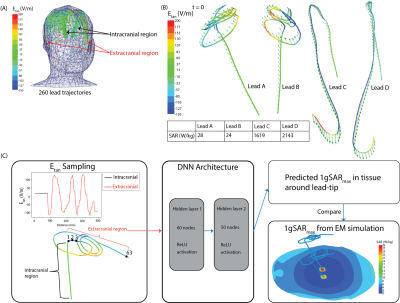 |
Using deep neural networks to predict RF heating of implanted conductive leads exclusively from implant trajectory and RF coil features
Jasmine Vu1,2, Bach T Nguyen2, Bhumi Bhusal2, Justin Baraboo1,2, Joshua Rosenow3, Ulas Bagci 2, Molly G Bright1,4, and Laleh Golestanirad1,2
1Biomedical Engineering, McCormick School of Engineering, Northwestern University, Evanston, IL, United States, 2Radiology, Feinberg School of Medicine, Northwestern University, Chicago, IL, United States, 3Neurosurgery, Feinberg School of Medicine, Northwestern University, Chicago, IL, United States, 4Physical Therapy and Human Movement Sciences, Feinberg School of Medicine, Northwestern University, Chicago, IL, United States
Safety risks associated with radiofrequency (RF) heating of tissue around implanted leads limit MRI accessibility for patients with active electronic implants such as those with deep brain stimulation (DBS) devices. RF heating is highly sensitive to the trajectory of the implanted lead, and full-wave electromagnetic simulations are currently the standard method for quantifying RF heating, requiring extensive computational resources and simulation time. Here, we present a promising, fast approach for predicting trajectory-specific maximum local specific absorption rate (SAR) in the tissue around tips of implanted lead models using deep learning.
|
|||
2280.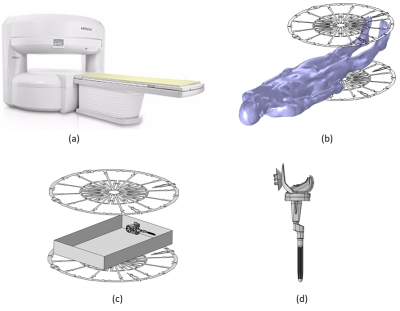 |
RF-Induced Heating of Medical Devices in an Open Bore MRI
Seoggwan Kim1, Amy Kester1, Alan R. Leewood1, and David C. Gross1
1MED Institute Inc., West Lafayette, IN, United States
The goal of this study was to develop a computational model that can accurately predict the radiofrequency (RF) induced temperature rise of medical devices in a 1.2T (49 MHz) Hitachi Oasis open bore system for the purpose of MRI labeling according to ASTM F2503. A comparison of experimental and analytical temperature rise of calibration rods, a stent, and a knee implant within a gel phantom was conducted. Simulations of RF heating of the stent and knee implant within the Duke virtual human model were compared for the 1.2T Hitachi Oasis open bore and 1.5T Siemens Avanto closed bore MRI systems.
|
|||
2281.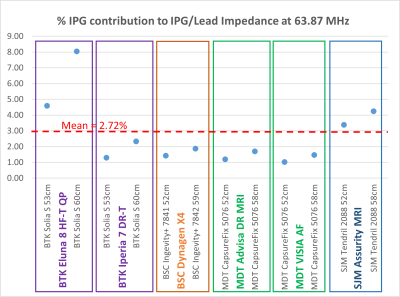 |
RF Impedance of MR-Conditional Pacemaker Leads when Connected to Implantable Pulse Generators from Different MR-Conditional Systems
David Prutchi1, Jason Meyers1, and Ramez Shehada2
1Impulse Dynamics (USA) Inc., Marlton, NJ, United States, 2Medical Technology Laboratories, La Mirada, CA, United States
RF-induced heating of an active implantable medical device (AIMD) composed of a pulse generator (IPG) and leads depends on the transmission line impedance of the lead and its proximal-end termination by the impedance of the IPG. We demonstrate that the RF impedance of IPGs is minimal relative to that of the leads, which dominates the overall impedance of the implantable system. Accordingly, mixed hybrid systems composed of MR-Conditional leads and any MR-conditional IPG are expected to have a comparable overall impedance and consequently produce the same RF-induced heating as their corresponding original systems specified by the manufacturers.
|
|||
2282.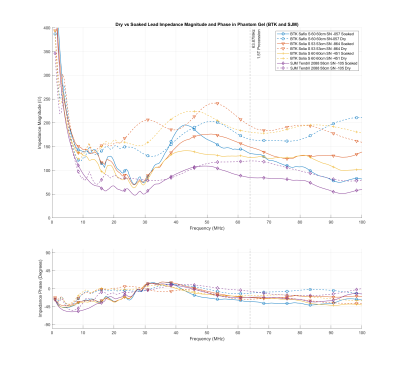 |
Importance of Pacemaker Lead Preconditioning for MR Safety In-Vitro Studies
David Prutchi1, Jason Meyers1, and Ramez Shehada2
1Impulse Dynamics (USA) Inc., Marlton, NJ, United States, 2Medical Technology Laboratories, La Mirada, CA, United States
This study investigates the change in the RF filtering characteristics of the leads of active implantable medical devices (AIMDs) as body fluids seep into the leads during the initial post-implant period. Our findings indicate that the RF characteristics change dramatically with fluid absorption, making it necessary to precondition the leads by soaking in isotonic saline solution to simulate the in-vivo scenario when conducting in-vitro MR safety testing. Furthermore, leads designed with RF-attenuating lumped inductances must consider the effect of fluid absorption on changing the peak RF attenuation frequency.
|
|||
2283.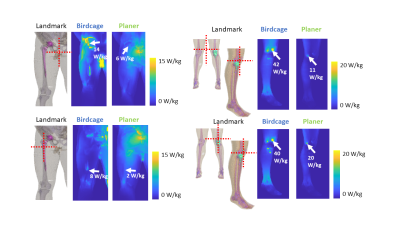 |
Radio-Frequency Induced Heating of Hip and Knee Implants in the Cylindrical and Planar Systems
Kyoko Fujimoto1, Tayeb A Zaidi1, Dave Lampman2, Josha W Guag1, Shawn Etheridge2, Hideta Habara3, and Sunder S Rajan1
1Center for Devices and Radiological Health, US Food and Drug Administration, Silver Spring, MD, United States, 2Hitachi Healthcare Americas, Twinsburg, OH, United States, 3Healthcare Business Unit, Hitachi, Ltd., Tokyo, Japan
Radio-Frequency (RF) induced thermal injury is a common adverse event reported to US Food and Drug Administration. RF-induced heating risk depends on the interaction of implantable medical devices with electric field distribution in the MRI systems. A study showed that RF-induced heating of a neuromodulation device was much lower in the planar system compared to the cylindrical system. In this study, the hip and knee implants were studied in an anatomical human model at a 1.2T planar system and a 1.5T cylindrical system.
|
|||
2284.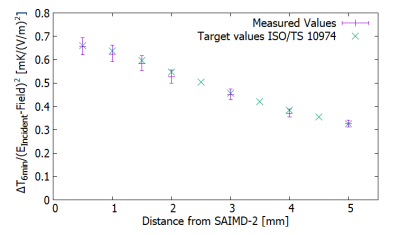 |
Validation of a new 64MHz RF exposure system for testing medical implants for RF-induced heating according to ASTM-F2182 and ISO/TS 10974
Finya Ketelsen1,2, Kevin Kröninger2, and Gregor Schaefers1,3
1MRI-STaR - Magnetic Resonance Institute for Safety, Technology and Research GmbH, Gelsenkirchen, Germany, 2TU Dortmund University, Dortmund, Germany, 3MR:comp GmbH, Testing Services for MR Safety & Compatibility, Gelsenkirchen, Germany
To determine the RF-induced heating of implants, it is necessary, that the RF field source used for testing fulfills several requirements. This study introduced the validation of a new developed linear exposure system for testing.
The results for E-Field distributions from numerical simulations are validated experimentally by measuring these E-field distributions. Furthermore, the temperature rise at the 100mm titanium rod is compared with the target values form ISO/TS 10974 Annex I. The system fulfills the requirements and is suitable for testing active and passive implants for RF-induced heating according to ASTM F2182 and ISO/TS 10974. |
|||
2285.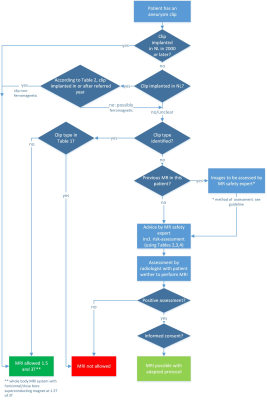 |
MRI in patients with a cerebral aneurysm clip; Guideline in the Netherlands
Mark BM Hofman1, Cristina Lavini2, Albert van der Zwan3, Carola van Pul4, Sara H Muller5, Mette K Stam6, Marinette van der Graaf7, Carla Kloeze8, Bastiaan J van Nierop9, Wouter Teeuwisse10, Peter Kappert11, Evie EM Kolsteren12, Kristie Venhorst12,
and Joost PA Kuijer13
1Radiology and Nuclear Medicine, Amsterdam UMC, Vrije Universiteit, Amsterdam, Netherlands, 2Radiology and Nuclear Medicine, Amsterdam UMC location AMC, Amsterdam, Netherlands, 3, Neurology and Neurosurgery, UMC Utrecht Brain Center, Utrecht, Netherlands, 4Maxima Medical Centre, Eindhoven, Netherlands, 5Antoni van Leeuwenhoek Hospital, Amsterdam, Netherlands, 6Radiology, LUMC, Leiden, Netherlands, 7Imaging, Radboud UMC, Nijmegen, Netherlands, 8Catharina Hospital, Eindhoven, Netherlands, 9Radiology and Nuclear Medicine, University Medical Centre Utrecht, Utrecht, Netherlands, 10CJ Gorter Center for High Field MRI, LUMC, Leiden, Netherlands, 11Radiology, UMCG, Groningen, Netherlands, 12Knowledge Institute Medical Specialists, Utrecht, Netherlands, 13Radiology and Nuclear Medicine, Amsterdam UMC, Vrije Universiteit Amsterdam, Amsterdam, Netherlands
The Dutch Association of Medical Specialists wrote a guideline for MR safety experts for an MRI examination in a patient with a cerebral aneurysm clip for known and unknown clip types. Risk stratification for unknown clip types was based on a survey in the Netherlands that identified time frames and locations of ferromagnetic clip use.
|
|||
2286.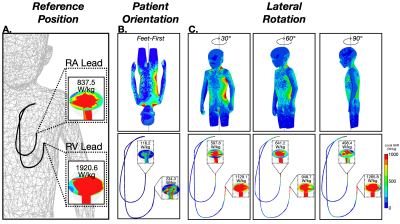 |
Pediatric Patient Positioning Can Reduce Local-SAR at the Pacemaker Lead-tip During MRI Exams
Jessica A. Martinez1 and Daniel B. Ennis1,2,3
1Department of Radiology, Stanford University, Stanford, CA, United States, 2Cardiovascular Institute, Stanford University, Stanford, CA, United States, 3Maternal & Child Health Research Institute, Stanford University, Stanford, CA, United States
Pediatric patients with cardiac implantable electronic devices (CIEDs) are generally contraindicated for MRI exams. Previous work in the adult population suggests that RF heating strongly depends on the patient’s position and orientation within the MRI scanner. The objective of this work was to evaluate in silico several pediatric patient-positions within the MRI scanner as methods to reduce RF-heating.
|
|||
2287.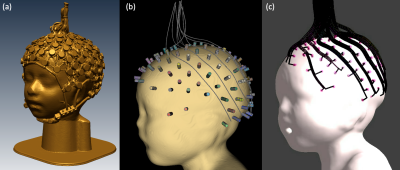 |
RF safety simulation of 128-channel EEG net on a 29-month-old whole-body model at 3T
Hongbae Jeong1,2 and Giorgio Bonmassar1,2
1Athinoula A. Martinos Center for Biomedical Imaging, Massachusetts General Hospital, Charlestown, MA, United States, 2Department of Radiology, Massachusetts General Hospital/Harvard Medical School, Boston, MA, United States
In this study, RF heating of an EEG on a 29-month-old whole-body voxel model in a 3T MRI was studied with numerical simulation using Sim4Life. 128-channel EEG leads and electrodes were drawn on the head of the 29-month-old voxel model, and the position of the EEG electrodes was estimated from the 3D scan of the EEG net. The 10gSARmax and the SARhead were assessed in the model with and without the EEG net in birdcage transmit body coil at 3T. In both cases, estimated results of SAR were well-below the RF safety limit in the international standard.
|
|||
2288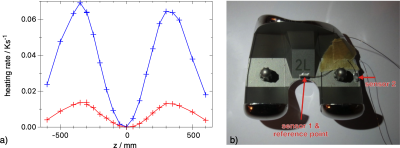 |
Experimental validation of simulated implant heating induced by switched gradient fields Video Permission Withheld
Rüdiger Brühl1, Thomas Schwenteck1, Bernd Ittermann1, Fabio Baruffaldi2, Alessandro Arduino3, Umberto Zanovello3, Luca Zilberti3, Mario Chiampi3, and Oriano Bottauscio3
1Physikalisch-Technische Bundesanstalt (PTB), Berlin, Germany, 2IRCCS Istituto Ortopedico Rizzoli, Bologna, Italy, 3Istituto Nazionale di Ricerca Metrologica (INRIM), Torino, Italy
Switching MR gradients induce eddy-currents in metallic implants. Gradient-aggressive MR sequences were used on a commercial 3 T scanner to heat orthopaedic prostheses ex vivo. Heating experiments are presented, and the measured temperature evolution is compared with corresponding numerical results. Numerical simulations have been successfully validated for five MR sequences at different implant position and orientations in the gradient field.
|
|||
2289.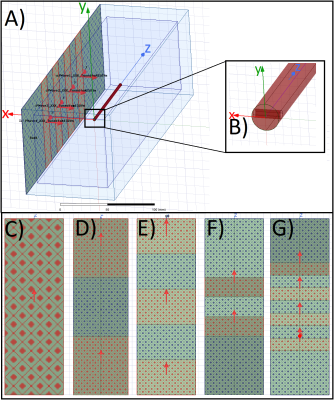 |
Numerical Simulation study on the effects of intentionally inhomogeneous E-field distributions on RF-induced heating of implants
Vincent Hammersen1, Finya Ketelsen1, Andreas Rennings2, and Gregor Schaefers1,3
1MRI-STaR Magnetic Resonance Institute for Safety Technology and Research GmbH, Gelsenkirchen, Germany, 2General and Theoretical Electrical Engineering (ATE), University of Duisburg-Essen, Duisburg, Germany, 3MR:comp GmbH, Gelsenkirchen, Germany RF-induced heating of implants is strongly dependent on the E-Field magnitude at the test location, which is why a universal ±1dB and ±20° phase shift target field value limit is applied. We used numerical simulation to vary the exposing E-Fields, while keeping a constant average E-field magnitude at the test location. Strong deviations in heating development could be observed. In a second step we added phase shifts between exposition sources. The results suggest that, in addition to the limits, the exact field distribution especially the E-field directions should also be taken into account in critical inhomogeneous cases. |
|||
2290.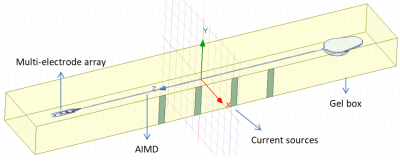 |
Lead electromagnetic models for RF-induced heating in multi-electrode cortical implants
Mubashir Hussain1 and Gregor Schaefers1,2
1Magnetic Resonance Institute for Safety, Technology and Research GmbH, Gelsenkirchen, Germany, 2MR:comp GmbH, Testing Services for MR Safety & Compatibility, Gelsenkirchen, Germany
This work focus on estimating the RF-induced deposited power at the multi-electrode array of cortical implant (CorTec GmbH, Germany) by means of lead electromagnetic models (LEM). To develop the LEM for such a complex structure, we computed the transfer function for each of the electrode and generated a set of artificial tangential electric fields for validation of the LEM. The transfer functions and the tangential electric fields along the leads are then used to develop the LEM which can estimate the deposited power at the electrode array for an arbitrary lead pathway.
|
|||
2291.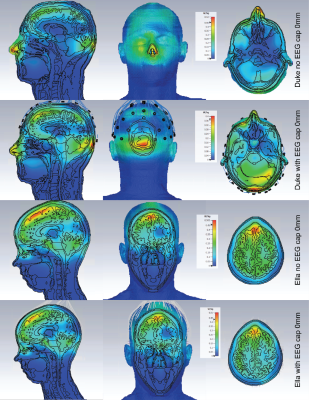 |
Numerical Modelling of a Close-fitting 8-channel Transceiver Head Coil and EEG Electrodes for Safety Validation at 7T
Paul Mcelhinney1, Sarah Allwood-Spiers2, Gavin Paterson1, Marios Philiastides1, and Shajan Gunamony1
1University of Glasgow, Glasgow, United Kingdom, 2NHS Greater Glasgow and Clyde, Glasgow, United Kingdom
Simultaneous use of EEG and fMRI at high fields (UHF, ≥7T) offers the dual benefits of a high spatial resolution as well as the ability to study dynamic brain processes. A close fitting coil design has been built for this purpose, having open access to the subject and the EEG hardware while maintaining excellent performance characteristics. We present here the results from computer simulations of the head coil, including the EEG cap using human body models for safety validation and optimization of the design.
|
|||
2292.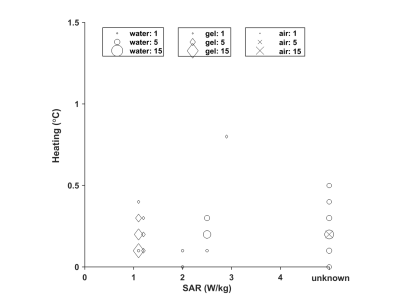 |
MRI in patients with a prosthetic heart valve, annuloplasty ring or mitra clip; Guideline in the Netherlands
Mark BM Hofman1, Carla Kloeze2, Bastiaan J van Nierop3, Sara H Muller4, Joost PA Kuijer1, Kristie Venhorst5, Cristina Lavini6, Mette K Stam7, Carola van Pul8, Wouter Teeuwisse9, Marco JW Gotte10, Peter Kappert11, Evie EM Kolsteren5,
and Marinette van der Graaf12
1Radiology and Nuclear Medicine, Amsterdam UMC, Vrije Universiteit Amsterdam, Amsterdam, Netherlands, 2Catharina Hospital, Eindhoven, Netherlands, 3Radiology and Nuclear Medicine, University Medical Centre Utrecht, Utrecht, Netherlands, 4Antoni van Leeuwenhoek Hospital, Amsterdam, Netherlands, 5Knowledge Institute Medical Specialists, Utrecht, Netherlands, 6Radiology and Nuclear Medicine, Amsterdam UMC location AMC, Amsterdam, Netherlands, 7Radiology, LUMC, Leiden, Netherlands, 8Maxima Medical Centre, Eindhoven, Netherlands, 9CJ Gorter Center for High Field MRI, LUMC, Leiden, Netherlands, 10Cardiology, Amsterdam UMC, Vrije Universiteit Amsterdam, Amsterdam, Netherlands, 11Radiology, UMCG, Groningen, Netherlands, 12Imaging, Radboud UMC, Nijmegen, Netherlands
Can a patient with a prosthetic heart valve, annuloplasty ring or a mitra clip undergo an MRI examination? The Dutch Association of Medical Specialists (FMS) wrote a guideline, using searches of guidelines, literature, implant databases, and incident databases. The recommendation is: scan the patient with a prosthetic heart valve, annuloplasty ring or mitra clip with an 1.5T or 3T whole body MRI system with a horizontal closed bore superconducting magnet without further restrictions.
|
|||
2293.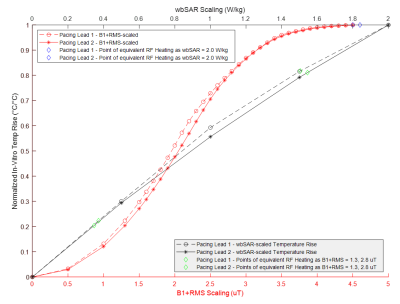 |
Comparing RF Heating Based on SAR vs. B1+RMS MRI Conditional Labeling
Negin Behzadian1 and Shiloh Sison2
1Research and Development, Abbott, Sylmar, CA, United States, 2Research and Development, Abbott, Sunnyvale, CA, United States
MRI RF heating can cause thermal damage to biological tissues, especially in patients with leaded implantable devices, by concentrating power deposition at the implant-tissue interface. With the emergence of B1+RMS as a more precise RF exposure metric than SAR, implantable device manufacturers have begun MR conditional labeling to fixed B1+RMS levels, in addition to SAR labeling. Our study characterizes the relationship between RF heating per SAR vs. B1+RMS-based scaling methods in the context of 3T Normal Operating and First Level Controlled Mode MRI exposure.
|
|||
2294.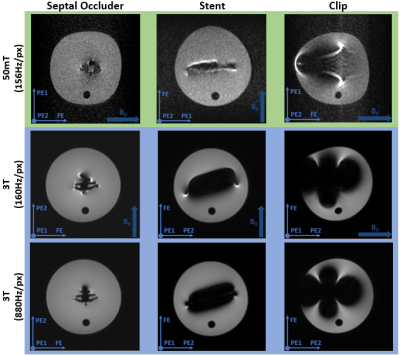 |
Quantification of safety and image quality in low field MRI in the presence of medical implants.
Camille D.E. Van Speybroeck1, Wouter M. Teeuwisse1, Tom O'Reilly1, Paul M. Arnold2, and Andrew G. Webb1
1G.J. Gorter Center for High Field MRI, Leiden University Medical Center, Leiden, Netherlands, 2Neurosurgery, Carle Foundation Hospital, Urbana, IL, United States
Very little quantitative data exist on safety aspects of medical implants in low field MRI systems. Protocols for clinical scanners must be adjusted due to differences in bore size and B0 direction. We present measured and simulated data on magnetically induced displacement forces, image artifacts and SAR on a 50 mT portable MRI system. Results show that some implants must be considered MR unsafe even at 50 mT, that image artifacts are less compared to 3 T even with much lower gradient strengths, and SAR limits can be breached if using very short pulses and inter-echo times in TSE sequences.
|
|||
2295.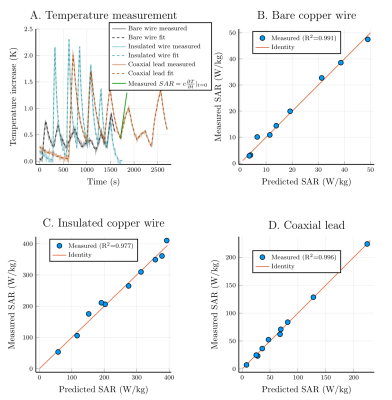 |
A Single Setup Approach for the MRI-based Measurement and Validation of the Transfer Function of Elongated Medical Implants
Peter Stijnman1,2, Arcan Erturk3, Cornelis van den Berg1, and Alexander Raaijmakers1,2
1Computational Imaging, UMC Utrecht, Utrecht, Netherlands, 2Biomedical Engineering, Eindhoven University of Technology, Eindhoven, Netherlands, 3Medtronic, Minneapolis, MN, United States
A new method to validate the transfer function (TF) of linear implants was developed, using an independent RF transmitter. A simulation study was performed exploring different methods to change the incident electric field, local transmit coils positioned at various locations is most effective for the validation. A benefit is the constant position of the leap tip and the temperature probe. We performed a TF measurement and validation study for three leads. The simulated incident electric fields of the local transmit coils and the measured TF were used to predict tip heating, verified by temperature probe measurements showing excellent agreement ($$$R^2\geq0.977$$$).
|
|||
2296.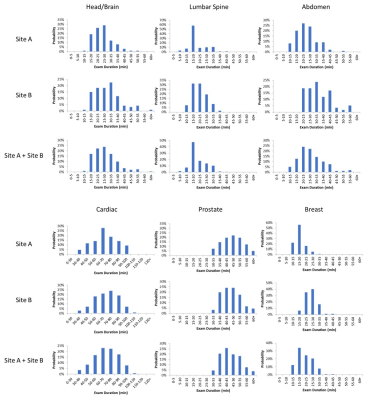 |
Analysis on 1.5T MR clinical scan time of patients from multiple imaging centers
Yuqing Wan1, Nathan Ooms2, Paul Nguyen1, and Guangqiang (Jay) Jiang1
1Axonics Modulation Technologies, Irvine, CA, United States, 2Purdue University, West Lafayette, IN, United States
This study reported magnetic resonance imaging (MRI) examination duration of 974 patients collected from two imaging sites. Statistical scan time analysis was performed, and distributions were obtained for different scan regions. Scan time disparities were found between the two imaging sites due to the sequence selections and configuration, which may impact imaging cost and image quality. The clinical examination duration data provides useful information for implant device manufacturers to define practical MRI conditions that improve the patients’ overall MR experience.
|
|||
2297. |
An anthropomorphic phantom for deep brain stimulation MRI safety investigations
Benson Yang1,2, Fred Tam1, Benjamin Davidson3, Clement Hamani3,4, Nir Lipsman1,3,4, Chih-hung Chen2, and Simon J Graham1,5
1Physical Sciences, Sunnybrook Research Institute, Toronto, ON, Canada, 2Electrical and Computer Engineering, McMaster University, Hamilton, ON, Canada, 3Division of Neurosurgery, Sunnybrook Health Sciences Centre, Toronto, ON, Canada, 4Harquail Centre for Neuromodulation, Sunnybrook Research Institute, Toronto, ON, Canada, 5Department of Medical Biophysics, University of Toronto, Toronto, ON, Canada
Magnetic resonance imaging of deep brain stimulation (DBS) patients remains a safety concern at higher magnetic fields strengths. Phantoms play an important role in validating and estimating patient safety conditions. However, conventional phantoms are typically simple homogeneous structures that limit the ability to replicate DBS surgical implant procedures. In this work, a new phantom structure is proposed with more human-like realism and compartments to enable improved replication of DBS device placement geometries. Preliminary radiofrequency heating results demonstrate significant differences in temperature elevations when the phantom is assembled in a heterogeneous and homogeneous configuration.
|
The International Society for Magnetic Resonance in Medicine is accredited by the Accreditation Council for Continuing Medical Education to provide continuing medical education for physicians.